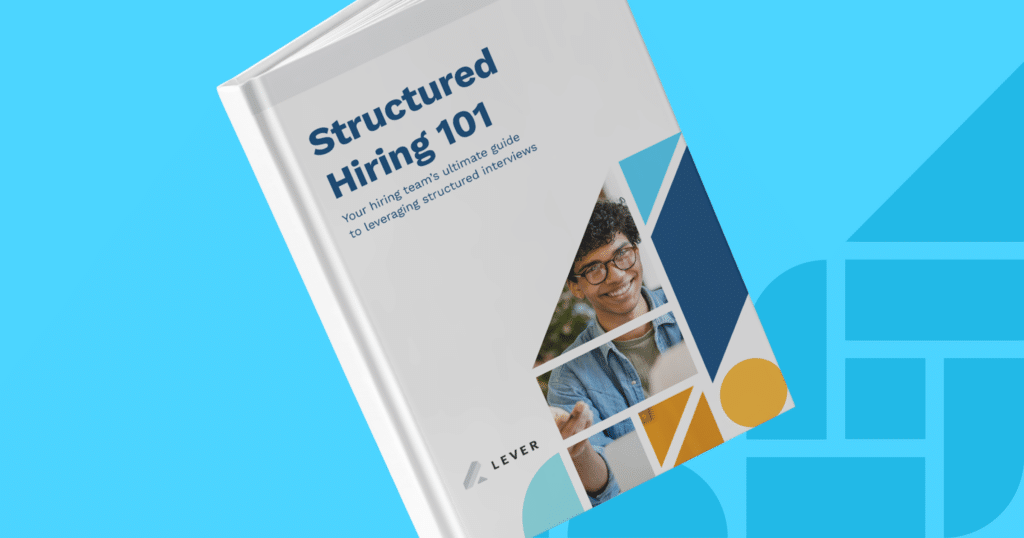- Structured interviews 101
- What is a structured interview?
- Why are structured interviews more effective?
- Why should you use structured interviews?
- Structured vs unstructured interviews
- Structured vs semi-structured interviews
- How to develop a structured interview process
- Conducting a structured interview
- Examples of structured interview questions
- Structured hiring 101 eBook
Structured interviews 101
Interviews are a necessary part of your hiring process, and yet, determining whether a candidate is right for a role can be challenging. Can a one-hour interview truly tell you everything you need to know before hiring a new team member?
For this reason alone, many recruiting teams involve more than just a hiring manager or talent acquisition leader in the interview process. For example, when hiring for a customer success role, you’ll likely include a Senior Customer Success Manager and Customer Success Technician in interviews so they can ask pertinent questions and get to know candidates.
Which questions will these team members ask, and how will they assess whether a candidate is the right fit? Ensuring everyone involved in the hiring process is aligned is critical to running successful, fruitful interviews, and yet, many teams struggle with keeping interviews aligned with hiring goals and objectives.
This is where structured interviews come in. They can help improve and streamline your hiring process while eliminating bias in your interviews. The question is, how?
Structured interviews are the best way to hire the right candidates
Conducting job interviews can seem pretty straightforward.
Candidates come into your talent pipeline for an open role, you choose the ones you’d like to interview, and you ask them a series of questions. Based on their responses and your experience, you move forward with the candidate you think best fits the role.
Upon second glance, however, you’ll find that a brief interview and a ‘gut feeling’ aren’t enough to make the most effective hiring decisions—especially when other stakeholders or influencers are involved.
Hiring the wrong candidate can be costly. Studies have shown that, on average, a bad hire can cost a company upwards of $15,000. Meanwhile, 74% of managers say they’ve hired the wrong person for a position at one time or another.
To help you choose the right candidates, a structured interview process is key. According to research, structured interviews are twice as effective at predicting job performance as unstructured ones and can help eliminate or reduce confirmation bias in your hiring.
What are structured interviews, and how can you conduct them? In this guide, we’re going to walk you through everything you need to know about structured hiring—with a few examples of questions you can ask, too. Let’s dive in!
What is a structured interview?
A structured interview (also referred to as a ‘structured job interview’) is a method of assessment that measures how competent a candidate is for a role by asking all candidates the same set of questions and comparing them against the same criteria.
We’ve all experienced an unstructured interview—one where the conversation is free-flowing and the interviewer asks whichever questions they like, often based on the direction of the conversation or the candidate’s resume.
However, structured interviews require a hiring team to develop a clearly defined purpose for each interview, along with a specific set of questions for each interviewer to ask. This includes a rubric or scorecard of some kind that helps interviewers assess answers to each question. This means:
- All candidates are asked the same predetermined questions, in the same order
- All candidates’ responses are evaluated using the same criteria or scale
By following a structured interview framework, hiring teams can make more informed, data-driven decisions rather than hiring based on emotion or those ‘gut feelings’ that don’t always lead to onboarding the right candidate.
Why are structured interviews more effective?
Many recruiters consider structured interviews to be more effective, as they’re based on a clearly defined role and its core objectives—a hiring team uses a rubric and deliberate set of questions that foster data-driven hiring decisions.
Like any assessment method, however, there are both pros and cons to using structured interviews. Keep in mind that any interview method or framework you use should be geared towards helping you hire the right candidate based on facts and data, as opposed to personal bias or subjective evaluation.
Advantages of structured interviews
Let’s take a look at the key advantages of using structured interviews.
- Better predict job performance — as we mentioned above, studies have shown that structured interviews can help you better predict a candidate’s job performance.
- Eliminate confirmation bias — all candidates are asked the same questions and are assessed using the same rubric, helping ensure your hiring is equitable while decreasing the risk of confirmation bias.
- Data-driven vs emotional hiring — as candidates are assessed based on standardized criteria rather than ‘gut instinct’ or feeling, hiring teams can make more data-driven hiring decisions.
- Optimize interview time — having a structured interview framework in place can help managers and stakeholders optimize the time they have with each candidate.
Tip
When it comes to streamlining interviews, structured interview frameworks can be a tremendous asset for recruiters. Google found, for example, that leveraging structured interviews saves their hiring managers an average of 40 minutes per interview.
Disadvantages of structured interviews
Now, let’s consider a few of the drawbacks of structured interviews.
- They take time to prepare — an effective structured interview framework takes time to prepare; your team needs to be ready and willing to write, test, and train other recruiters with your framework.
- You have to update your framework — dedicating time to updating aspects of your structured interviews (such as the questions you ask) is crucial, especially as your team grows and your hiring needs change.
- There’s a lack of personalization — because structured interviews utilize predetermined and standardized questions, there’s not as much opportunity to hyper-personalize your interviews.
Structured interviews may not be for everyone. However, they can be a game-changer for both your hiring and your company’s candidate experience. We’ll explain below!
Why should you use structured interviews?
If structured interviews are more effective, why don’t all hiring teams use them when recruiting and nurturing candidates? Well, it could have a lot to do with comfort.
Research has shown that, in general, interviewers tend to think they’re great at interviewing, so few will update their skills or practice new ways of conducting interviews. But interviewing can quickly become an informal, almost casual process if you’re tasked with interviewing candidates often or at scale. This can lead to ineffective interviews that hinder hiring teams from properly assessing candidates—and can result in the ‘interview effect.’
In short, the ‘interview effect’ occurs when an interviewer unintentionally influences the interviewee. For example, an interviewer’s body language and responses can influence how a candidate answers questions. Given interviews are social interactions, a casual or unstructured approach can bias people’s responses or behaviors in an interview.
In this sense, having a structured interview framework in place enables your hiring team to conduct more effective, unbiased interviews. There are benefits for both organizations and candidates.
How structured interviews benefit candidates and employers
The intention behind structured interviews is to help recruiters and hiring teams make objective hiring decisions, which ultimately benefits both the candidate who gets hired and the organization.
Structured interviews benefit candidates in a few key ways:
- Candidates are assessed based on skills and qualities as they relate to the core objectives of the role (versus personal preference)
- All candidates are asked the same questions and assessed using the same criteria, making the hiring process more intentional and fair
- Interviews are more deliberate and outcome-oriented, which maximizes the time a candidate has with a hiring manager
Structured interviews benefit employers as they:
- Help to reduce unconscious bias and/or confirmation bias in interviews
- Create a more deliberate, intentional, and standardized process for interviews that helps hiring teams choose the right candidates
- Allows hiring teams to leverage their time with candidates more productively by asking the right questions
We’ve talked about structured interviews and why your hiring team should leverage them—but what’s the difference between a structured and unstructured interview? And what about semi-structured interviews? The three types can be confusing, so let’s break them down.
The ‘interview effect’ occurs when an interviewer unintentionally influences the interviewee. For example, an interviewer’s body language and responses can influence how a candidate answers questions. Given interviews are social interactions, a casual or unstructured approach can bias people’s responses or behaviors in an interview.
Structured vs unstructured interviews
A job interview is a formal conversation between a hiring manager and a candidate to determine whether they are the right fit for a particular role.
Today, job interviews are conducted in a number of different ways and can include multiple steps and touchpoints. Think about virtual, in-person, and telephone interviews—along with one-on-one, panel, or group interviews. Whichever format you choose, a job interview can be structured in one of three ways:
- Unstructured
- Semi-structured
- Structured
What are the core differences between these three interview types, and why or when should you leverage each? We’ll start with structured vs unstructured interviews.
Structured interviews
In a structured interview, the interviewer asks a specific series of predetermined questions. These questions are planned in advance so that each candidate is asked the same set of questions in the same order.
You may also see or hear structured interviews referred to as ‘planned interviews’ or ‘formalized interviews’ but the objective is the same: setting a standardized process for interviewing candidates.
Structured interviews are your safest bet when conducting more equitable and inclusive interviews, as you’re required to stick to a prescribed process that assesses candidates fairly, not subjectively.
PRO TIP
Though structured interviews are best leveraged throughout your entire interview process, if your company has a particular method for interviewing, consider using structured interviews at the beginning of your hiring process. It’s during this time that you’ll want to gain a better understanding of a candidate’s hard and soft skills, along with their experience and why they’re interested in your role.
Unstructured interviews
Structured interviews seem pretty straightforward, so what is an unstructured interview?
In an unstructured interview, an interviewer leads the discussion and asks questions without any preparation. So, questions are not predetermined and there is no path or process put in place beforehand. In other words, the interviewer flies by the seat of their pants!
Otherwise known as ‘informal interviews’ or a ‘non-directive interview,’ unstructured interviews have recruiters or hiring managers asking random sets or types of questions—this means each candidate is asked different questions and may be given different scenarios to respond to (and there is no set order or prescribed rubric).
Be careful with leveraging this interview type at the outset of your hiring process. Unlike structured interviews, unstructured ones can quickly lose sight of the purpose or aim of the interview and can lead to biased questions and responses.
PRO TIP
If you’re implementing unstructured interviews, use them only when you’ve already had a couple of touchpoints with a candidate and are getting to know them on a personal level, such as gauging culture-add.
Structured vs semi-structured interviews
We’ve gone over structured and unstructured interviews; now, we need to answer the question, “what are semi-structured interviews?”
Think of semi-structured interviews as a hybrid interview; the interviewer doesn’t ask a formalized set of questions but instead sticks to a brief list of predetermined talking points while letting the rest of the conversation flow naturally.
For example, they could ask the candidate more open-ended questions or allow the candidate to ‘lead’ the interview by speaking about their experiences and working style or asking the interviewer about the company culture.
The semi-structured interview approach is common among many hiring teams, and it has both its advantages and disadvantages. Like unstructured interviews, interviewers may be more subjective in their questions while letting bias creep in. However, some hiring managers are more comfortable with this hybrid approach and will still come prepared with a short list of questions to ask before letting the interview flow more casually.
PRO TIP
Semi-structured interviews may be your preference for panel or group interviews, such as when a candidate presents a skill test or assignment. Interviewers may have questions that come up based on the presentation or panel discussion, which means predetermined questions aren’t always leveraged.
How to develop a structured interview process
Now that we know the difference between the 3 types of interviews you can conduct, it’s time to put together a process or framework for leveraging structured interviews. Let’s get started with 4 simple steps.
Step 1: Determine your needs and core competencies
Before you can develop a process for your structured interviews, your hiring team first needs to determine what you’re looking for in your ideal candidates. What core competencies, skills, and experience would they need?
To answer these types of questions, lean on your job descriptions. You’ll have already outlined the needs and job requirements, which can help you and your team establish the skills, behaviors, and competencies you’re looking for.
Competencies aren’t just skills—they also include qualities, strengths, and attributes. With these competencies in mind, you can begin to flesh out the questions you’d want and need to ask a candidate during an interview to ensure you’re assessing them objectively against the needs of the role and hiring goals.
Step 2: Draft your interview questions
Once you’ve established the needs and competencies of a role, you can move on to choosing the interview questions you’ll ask candidates.
Typically, there are 2 types of questions that interviewers ask people most often: behavioral and situational. We’ve all been asked these types of questions, whether we’ve experienced structured or semi-structured interviews!
Tip
Avoid using brain teasers as questions to assess candidates, especially when assessing for cognitive ability. These forms of questions are unreliable in helping you predict a candidate’s future job performance and don’t accurately showcase their abilities or competencies.
What are behavioral interview questions?
Behavioral interview questions focus on how a candidate has handled various situations in the workplace in the past. Their purpose is to seek to understand a candidate’s past behavior and experience relevant to the job and often reveal insights about a candidate’s skills, personality, and character.
The idea here is that past behavior can help predict future job performance and whether a candidate will be a culture add versus a detractor. Keep in mind that behavioral questions are best used to assess traits and skills.
Example
“Can you give me an example of a time when you had to assume a leadership role?” or “Describe a project you’ve worked on and how you managed your time and deliverables.”
What are situational interview questions?
Situational interview questions are those that present candidates with hypothetical or potential scenarios. The purpose of these types of questions is to help the interviewer determine a candidate’s problem-solving or analytical skills.
Like behavioral interview questions, situational ones can help predict a candidate’s future job performance, but be careful with how you use these questions—if they’re not properly structured, they can lead to open-ended responses from candidates.
Example
“How would you approach a project where you and your fellow team members have to work with a difficult colleague?” or “What would you do if you were asked to perform a task or do work you’ve never done before?”
Before we move on, ensure the questions you ask are aligned to the competencies and objectives of the role you’re interviewing candidates for. Questions that don’t pertain to the role or responsibilities make for an ineffective interview process.
Step 3: Create your rubric
At this stage, you’ve established your needs for a role and have developed the questions you’ll want to ask every candidate. Now, it’s time to create your rubric.
Often compared or referred to as a ‘rating’ or ‘scale,’ a standardized rubric is crucial to helping every stakeholder in an interview process objectively assess candidates based on responses and conversations. And this rubric becomes even more essential if your team asks candidates to complete skill tests or panel presentations.
The purpose of a rubric is to help interviewers most accurately assess poor versus good responses, which typically follows a 1-5 scale rating, where 1 is ‘poor’ and 5 would be considered ‘excellent.’ Standardizing this rubric and ensuring all interviewers or panel participants use the same one will help in reducing bias and subjectivity.
PRO TIP
Your rubric should accommodate explanations for each rating an interviewer gives a candidate. For example, if an interviewer gives a candidate a score of 2 for a behavioral question, but a score of 5 for a situational one, they should give a detailed or illustrative explanation as to ‘why.’
In LeverTRM, for example, recruiters have access to customizable scorecards that can be used as rubrics when interviewing candidates, whether it’s during a one-on-one interview or a panel.
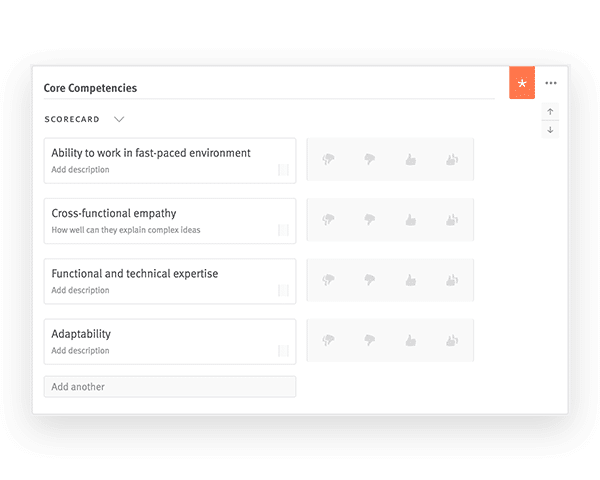
Step 4: Craft a feedback and debrief process
After you’ve interviewed candidates and have shortlisted potential hires, your team will need to debrief on the interviews and go over feedback that stakeholders have about each candidate. This is where your feedback process comes in.
Your team can leverage the rubric you used to consolidate feedback and review which candidates you’d like to move forward with into the final hiring stages. Consider having post-interview meetings slated in your team’s calendars to review feedback or shortlisted candidates.
Feedback happens at various stages of your interview process, and structured interviews can help ensure the feedback stakeholders give is objective rather than subjective. For example, in LeverTRM, recruiters can use structured interview kits and prescriptive feedback forms when they interview candidates. In LeverTRM, these forms are kept hidden until all interviewers have submitted their feedback, so that no one’s feedback is influenced by that of other stakeholders.
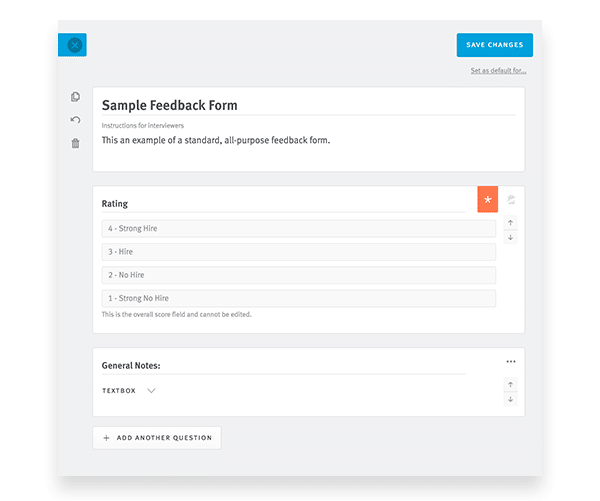
Conducting a structured interview
Up until now, we’ve gone over everything you need to know about structured interviews. However, to conduct a structured interview that’s successful in helping you assess and hire the right talent, it’s pertinent to know how you actually go about doing this type of interview!
Additionally, understanding how to compile your own structured interview kit can be helpful when moving away from unstructured interviews and semi-structured interviews. So, let’s dive in.
Creating your structured interview kit
The first step is to compile those interview questions we discussed above and standardize them based on the roles you’re hiring for.
For example, if you’re a technical recruiter who frequently hires developers and engineers, you can create predetermined lists of questions to use time and again. You may need to refresh these lists every so often, but these questions are a cornerstone of your kit.
PRO TIP
Create a template of your predetermined list of questions that you can upload or paste into your ATS. This will help you in keeping track of the questions you ask and the ones you update while giving other interviewers visibility into the standardized questions they should also be asking candidates.
Next, standardize your skills or competency tests
Skills tests or assignments are growing in popularity for many organizations whose hiring processes are a tad more nuanced than they once were.
These tests or assignments usually occur after the verification stage where candidates have an initial interview, meet with one or two strategic stakeholders, and then participate in a test or assignment they present to a panel or group. These assignments or tests are evaluated in different ways, however, it’s crucial they are standardized.
You want to give each candidate who moves forward to this stage of the hiring process a fair opportunity while eliminating any subjective assessment from interviewers. If each candidate has a different assignment, it can skew evaluations and feedback from interviewers (especially in a panel interview).
PRO TIP
When designing your standardized skill tests or assignments, ensure they allow candidates to present on skills and strengths that answer questions like, “Does the candidate understand the assignment?”, “Does the candidate apply their skills and insights to the assignment?” and “What is the quality of their work?”
Then, create or use templated feedback forms
A significant part of your structured interview kit will be your feedback forms. These can comprise your rubric or ‘scale’ for assessing candidates, but these forms should not just serve the purpose of rating candidates on a scale of 1-5.
Instead, feedback forms should encompass notes and feedback on responses from candidates (based on predetermined criteria or questions), notes on why interviewers have scored or rated candidates as they have, and any scorecards that hiring managers can review.
And, bear in mind, feedback should be objective and free of influence from other stakeholders. For example, the feedback one interviewer gives shouldn’t be used as a basis for the feedback another interviewer provides.
When feedback is provided, feedback forms are kept hidden so that interviewers can only view others’ feedback once they’ve completed their own. The goal in leveraging prescriptive feedback forms like the forms in LeverTRM is to eliminate groupthink so your hiring team makes objective and data-driven decisions that aren’t influenced by unconscious or confirmation bias.
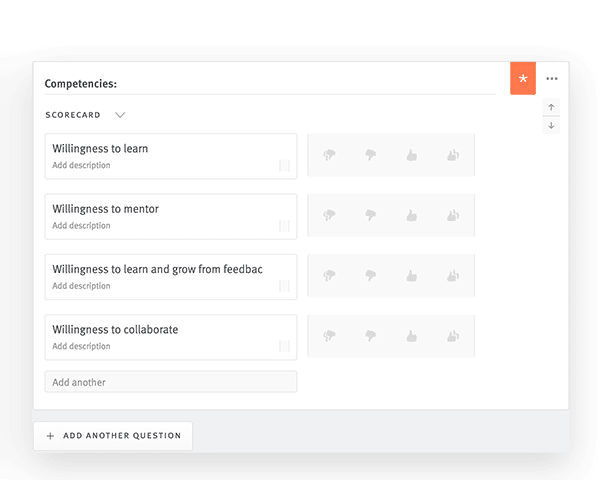
Finally, build out your candidate feedback surveys
Structured interviews don’t just benefit organizations—they’re also helpful for candidates in providing inclusive and equitable hiring experiences. But how do you know whether your structured interviews are effective in the eyes of those you’re interviewing?
A simple way of determining this is leveraging candidate feedback surveys. You can use these surveys to ask candidates about their interview experience while gathering insights into how fair, welcoming, and effective the interview was.
Say, for example, that you’ve just wrapped up a day of interviews with candidates, and you’d love to know how they felt about their interviews and what your team can improve upon. Using a feedback survey like those available in LeverTRM, you can ask follow-up questions to gauge sentiment and, further, determine whether your interviews were a positive experience for those you spoke with.
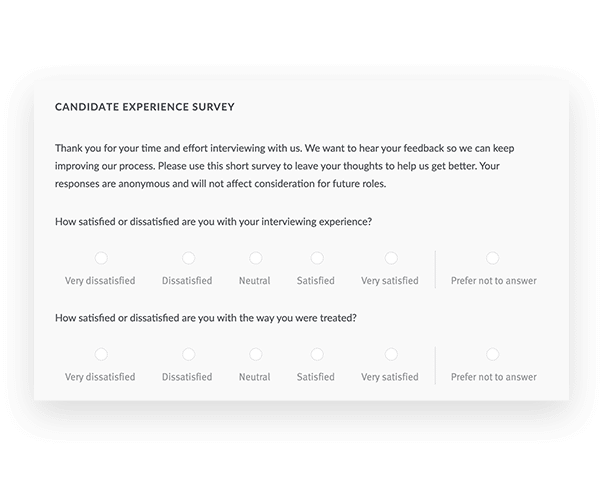
Now, you’re ready to interview
You’re now ready to conduct a structured interview that will set up both your hiring team and candidates for success! It’s time to prepare for your next structured interview. Here are some quick tips to keep in mind.
1. Give candidates insight into the interview process
When reaching out to applicants you’d like to interview, inform them about the next steps in your process and what your structured interviews look like. For example, you can make them aware of how long an interview usually lasts, anything they’ll need or should prepare beforehand, and the team members they’ll speak with. If your structured interview process is hyper-specific, you can share a brief overview in job postings, too.
2. Have your questions and rubric ready ahead of time
Ensure that you and any other interviewers are prepared with questions and your rubric or scorecards ahead of the interview. You want to streamline the entire process by making sure you’re asking each candidate the same questions, in the same order, and that everyone involved in the interview process is leveraging both question lists and the rubric you’ve put together.
3. Factor in time for notes
You’ll need time to take detailed notes during each interview, along with carving out time dedicated to answering any questions that candidates have. When setting up what your structured interview will look like, factor in when/how you’ll take notes and when you want to open the floor to candidates.
4. Inform candidates about next steps
Whether you’re moving forward with a candidate, have to deliver bad news, or want to send a follow-up feedback survey, most candidates will want to know what happens post-interview; even if they don’t ask! Inform each candidate about ‘what’s next’ when it comes to how you’ll communicate about the role, whether you’re going to request interview feedback, and when they can expect to hear from you.
PRO TIP
Planning on sending follow-up surveys to candidates post-interview? Ensure you’re asking for feedback that encompasses the entire interview process, not just questions around the interviewer. Ideally, candidates will provide feedback that will help you streamline your next interview.
Examples of structured interview questions
Creating a process for structured interviews seems simple enough, but crafting the right questions to ask candidates can be confusing if you’re moving from something like unstructured interviews to more standardized ones. We mentioned earlier that most structured interviews ask behavioral and situational questions; coming up with those types of questions can be challenging. So, let’s take a look at a few examples.
What questions should you include in a structured interview?
We’ll break down some examples for you based on the types of questions you can ask!
Verification questions
Think of these questions as the ‘yes or no’ questions you would typically ask at the outset of an interview—especially your first touchpoint with a candidate. Here are a few examples:
- Do you have experience using Adobe Creative Suite?
- Have you managed a distributed team before?
- Are you comfortable using marketing tools like Salesforce and Pardot?
- Do you feel you work well under pressure?
Behavioral questions
As we mentioned early on, behavioral questions help you gain insight into past performance. Here are some examples:
- Can you give me an example of a time you had to prioritize certain projects over others, and how you managed them?
- What was one of the more difficult decisions you’ve had to make that impacted your team, and how?
- How have you typically handled disagreements or conflicts with coworkers?
- Can you share how you set goals, objectives, and outcomes for the projects you work on?
Situational questions
Situational questions seek to dive deeper into a candidate’s problem-solving and analytical skills. Let’s look at a few sample questions:
- How would you handle a project whose scope of work requires multiple stakeholders from different teams?
- Describe how you would support a difficult or dissatisfied customer?
- Has there been a time you’ve had to work closely with a coworker you disagree with, and if so, how did you handle the situation?
- Tell me how you would approach managing a project where some stakeholders consistently miss deadlines?
PRO TIP
Remember, the questions you ask in a structured interview should always align with the role you’re interviewing candidates for. Keep in mind the core competencies you’re looking for in the right hire, and ultimately how you see a hire contributing to your business when developing your interview questions.
Get the secrets to structured hiring success with our eBook
Hiring the right people is a goal for every organization, but in today’s increasingly competitive talent landscape, candidate experience plays a crucial role in attracting those people to your company. Structuring hiring is the key, and our eBook shows you how your talent acquisition teams can set their hiring process up for success. Get your free copy of our structuring hiring 101 eBook!
